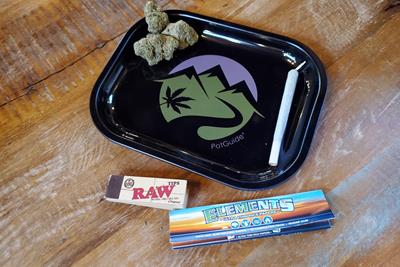
Sunday November 21, 2021
By Erin Hiatt
 420 Culture
420 Culture
If your go-to consumption method is to swing by the dispo and pick-up some pre-rolls, consider this a warning: because of supply chain disruptions in no small part due to the lingering pandemic, management platforms like MainStem are warning consumers that there is a cone shortage coming and it’s going to hit you right in the pre-roll.
Lucky for you, learning how to roll your own is pretty straightforward (even luckier for you, we’ve got your how-to here). All you need to do is gather some cannabis accessories like a grinder, rolling papers, material to make a crutch, and an oft-overlooked item, a rolling tray.
Why Use a Rolling Tray?
To roll a great joint to your liking (fat, thin, long, short?) you’re going to need a clean, flat surface. While you could use something like a plate, rolling trays are made specific to the purpose with their flat bottoms for smooth rolling and raised sides to reduce spillage of your precious herb.
You can also use a rolling tray to keep your rolling accessories all in one place. While many rolling trays are straightforward affairs, others feature separate compartments to store your rolled joints, herb, and other accessories. But rolling trays are affordable and versatile, and range from basic to custom, to holy cow - do I really need a gold-plated RAW rolling tray?
How to Choose the Right Rolling Tray for You
While choosing a rolling tray seems at first like simple proposition, there are actually several things to consider before buying:
Size
Do you plan to roll one joint at a time, or several in one sitting? How big are these joints? Do you need a lot of room? Do you plan to keep the tray at home or use it on the go? Size should follow function, so think specifically about what you’ll be using the tray for.

Larger trays offer more room to set up, but won’t transport as easily, and smaller trays are easier to take with you, but may not provide ample rolling space. A larger tray is also good if you tend to spill or struggle to keep your weed contained when rolling (this can be especially useful for anyone with lower levels of fine motor control or shaky hands; you’ll have a wider plate to catch any stray flower).
Material
As always, materials are a question of durability and usefulness and they have their pros and cons:
- Metal works well, has great durability, and is reasonably priced, however metal trays can be harder to clean once they get dirty (be careful not to scratch the finish), and if not treated properly can even rust (something you don’t want anywhere near what you’re smoking). It takes a lot to break a metal tray, and then, even if you somehow manage to break one, it won’t shatter or break (you’ll typically get a dent, at worst)..
- Plastic is the cheapest, but they are not as durable as metal, wood. Like metal trays, you’ll also need to take care when cleaning plastic trays to not scratch the plastic, as this can affect the coating and surface, making weed stick more and worse, potentially flaking into your weed.
- Of all the materials, wood is ideal because of design versatility and durability, but they can cost a bit more, and aren’t always as easy to clean depending on their coating. They can also can vary in weight depending on the wood used.
- Another “fancy” option is glass, which is durable and the easiest to clean, but heavy to transport, and can shatter if dropped. Like wood, glass also tends to fetch a higher price, depending on the quality.
- There are more exotic options out there as well, such as ceramic or stone (both great options depending on the finish). Both will vary in durability depending on their make, but expect to pay top dollar for these custom pieces.
PotGuide Tip: you’d be surprised by the wide variety of options you can find in the housewares section of your local thrift store that can be repurposed as a glass rolling tray. This can be a good place to find interesting wood trays at a lower cost as well.

Regardless of the material you choose, always go for a tray with a smooth surface so your weed won’t stick. It’s important to keep your tray clean, so consider whatever material you feel the most comfortable cleaning.
Cost
Most rolling trays of decent quality will cost anywhere from $8-15 dollars, though larger trays may go above $20. For higher quality metal trays with additional features, expect to pay up to $30. Glass trays start around $30 and go up from there. Wooden trays tend to cost the most and may go as high as $100, depending on its features (if you’re feeling really crazy, how about this custom rolling tray and accessories in 24k gold for a mere $795).
Lifted edges
The difference between a plate and a rolling tray is that trays are intended to catch and hold your herb while you’re rolling. Look for a curved edge high enough to keep your stash from falling out of the tray. Some trays will have straight edges, and those can be great for keeping things in place, but be prepared to fish weed out of the crevices from time to time.
Placeholder Slot, Storage, and Top Lidi
By getting a tray with some slots and storage, you will have a safe place to keep your rolled joints, grinder, crutches, etc. The lid, of course, has the added benefit of adding another level of protection (and is better for travel). There are all kinds of spins on the classic rolling tray design (and some literally spin for easy sharing). Some trays glow in the dark or even have LED lights. Almost any kind of accoutrement imaginable is out there.
Custom Rolling Trays
Some argue that to get the most out of your rolling experience you have to get a rolling tray set with all the bells and whistles, like removable ashtrays, holes to hold your blunt upright, compartments for your grinder and other bits and bobs. If you’re really into finding the perfect tray, there are places to customize your own, or check out this Etsy search result - where you can find more than 10,000 options. If you’re a woodworking enthusiast, or make your own pottery, consider making one yourself!

There are some reputable companies out there with a great variety of rolling trays and other accessories you could check out, including Raw, Cookies, and Mood Trays, where you can customize your own Bluetooth, audio lead, LED rolling tray. You can always keep it simple, too.
Conclusion
The humble rolling tray may seem like a small piece of cannabis technology, but it’s simplicity shouldn’t be taken for a lack of utility. A good rolling tray will help to make your rolling experience easier, cleaner and contained, allowing you to focus on what’s really important: rolling an excellent joint.
Frequently Asked Questions
What is a rolling tray?
Typically coming in metal, plastic, or wood, a rolling tray is a clean, flat surface with raised sides so you can roll your joints without spilling herb.
How do I make a rolling tray?
If you’re a DIY’er, to make a rolling tray you’ll need to procure a clean, flat surface, ideally with raised sides to keep your stash from falling. Let creativity be your guid, there are countless things that can be repurposed or customized. If you’d like to order a customized rolling tray, there are plenty of options, including My Rolling Tray and many others.
Do I need a rolling tray?
If you want to roll a nice joint and not waste any of your weed, a rolling tray is a must have.
What is the best rolling tray material?
Plastic is cheap but not as durable, metal is durable but can rust and can be difficult to clean. Wood may be your best bet, but wooden rolling trays tend to be more expensive than both plastic and metal. Glass trays are the easiest to clean, but heavy, pricier and can shatter if broken.







